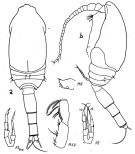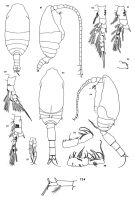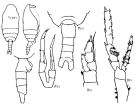|
|
 |
|
Calanoida ( Order ) |
|
|
|
Spinocalanoidea ( Superfamily ) |
|
|
|
Spinocalanidae ( Family ) |
|
|
|
Spinocalanus ( Genus ) |
|
|
| |
Spinocalanus similis Brodsky, 1950 (F,M) | |
| | | | | | | Syn.: | Spinocalanus similis profundalis (M) Brodsky, 1955 a (p.185, figs.M) | | | | Ref.: | | | Brodsky, 1950 (1967) (p.129, figs. F,M); Arashkevich, 1969 (p.700, figs.F); Damkaer, 1975 (p.44, figs.F,M); Brodsky & al., 1983 (p.292, figs.F,M, Rem.); Schulz, 1989 (p.189: Rem.); Bode & al., 2017 (p.600, Table I, fig. 2, 3, 4, morphology vs genetic). |  issued from : Brodsky K.A., Vyshkvartseva N.V., Kos M.S. & Markhaseva E.L. in Opred. Faune SSSR, 1983, 135. [p.293, Fig.141]. Female: a, habitus (diorsal view); b, idem (left lateral view); P. md: palp of Md; Md: masticatory edge of Md; Mxp: basipodal segments 1 and 2 of Mxp.
|
 issued from : Brodsky K.A., Vyshkvartseva N.V., Kos M.S. & Markhaseva E.L. in Opred. Faune SSSR, 1983, 135. [p.294, Fig.142]. Male: a, habitus (dorsal view); b, idem (left lateral view); Mxp: basipodas segments 1 and 2 of Mxp; Md: masticatory edge of Md. lb = left; np = right.
|
 issued from : D.M. Damkaer in NOAA Technical Report NMFS CIRC-391, Seattle, 1975. [p.45, Fig.86-97]. Female: 86, Female: habitus (dorsal); 87, idem (lateral left side); 88, basipod 1 and 2 of Mxp; 89, P1; 90, P2; 91, P3; 92, P4 (exopoddite incomplete); 154, terminal segments of A1. Male: 93, habitus (dorsal); 94, idem (left lateral side); 95, masticatory edge of Md; 96, basipod segments 1 and 2 of Mxp; 97, P5.
|
 Issued from : K.A. Brodskii in Calanoida of the Far Eastern Seas and Polar Basin of the USSR. Opred. Fauna SSSR, 1950, 35 (Israel Program for Scientific Translations, Jerusalem, 1967) [p.129 , Fig.47]. Female (from NW Pacif.): habitus (dorsal and lateral right side); posterior part of thoracic segments and urosome (dorsal); urosome (lateral right side); S1, P1; S3, P3. Nota: Cephalothorax 2.25 times abdominal length. Anal segment long, slightly longer than preceeding segment and equal to caudal rami. Caudal rami sligthly asymmetrical with larger right ramus. Genital segment only slightly shorter than the following two segments, ventral process greatly protruding but rounded. 2nd exopodal segment of P3 and P4 bearing two rows of spines, lower row composed of wide lamellar spines; distal segments with three groups of spines. 2nd and 3rd endopodal segments bearing tworows of spines; Basipod with three groups of spines. Exopod of P1 bearing long thin outer spines with apex protruding beyond the bases of the next spines; distal segment with naked posterior surface. Male: S5, P5.
|
 Issued from : M. Bode, S. Laakmann, P. Kaiser, W. Hagen, H. Auel & A. Cornils in J. Plankton Res., 2017, 39 (4). [p.604, Table I]. Species identified via morphological and molecular analyses, including the number of specimens used for each identification method (MI: morphological identification, COI: cytochrome c oxydase subunit I gene fragment, MS: MALDI-TOF analysis, 18 S: ribosomal 18 S gene fragment). Cryptic lineages were revealed only after molecular analysis. Sampling depth, latitude, total length (TL) and Prosome/Urosome ratio (Pr:Ur) of taxon were recorded. morphological characters are only listed here, if the identification was ambiguous due to missing body parts or if cryptic or pseudocryptic lineages were revealed during molecular analyses. For diagnostic character of species refer to the references: Park, 1970; Grice, 1971; Damkaer, 1975; Schulz, 1989, 1996. C = coxa; B = basis; P = swimming legs.
| | | | | Compl. Ref.: | | | Hattori, 1991 (tab.1, Appendix); Yamaguchi & al., 2002 (p.1007, tab.1); Galbraith, 2009 (pers. comm.); Homma & Yamaguchi, 2010 (p.965, Table 2); Homma & al., 2011 (p.29, Table 2, 3, abundance, feeding pattern: suspension feeders); Sano & al., 2013 (p.11, Table 6, Rem.: p.21, food habits) | | | | NZ: | 5 | | |
|
Distribution map of Spinocalanus similis by geographical zones
|
| | | | Loc: | | | Japan (off Sanriku), Station Knot (44°N, 155°E), NW Pacif., Kuril-Kamchatka, S Okhotsk Sea, Bering Sea, S Aleutian Basin, S Aleutian Is., British Columbia (rare), NW off Clipperton Is., SE Atlant. (25°S, 10°E) | | | | N: | 8 | | | | Lg.: | | | (13) F: 1,5-1,03; M: 1,6-1,4; (22) F: 1,5-1,4; M: 1,6-1,5; (1252) F: 1,63-1,76; {F: 1,03-1,76; M: 1,40-1,60} | | | | Rem.: | bathy & abyssopelagic. 2000-3000 (in Bode & al., 2017 at 25°S, 10°E) | | | Last update : 25/03/2020 | |
|
|
 Any use of this site for a publication will be mentioned with the following reference : Any use of this site for a publication will be mentioned with the following reference :
Razouls C., Desreumaux N., Kouwenberg J. and de Bovée F., 2005-2026. - Biodiversity of Marine Planktonic Copepods (morphology, geographical distribution and biological data). Sorbonne University, CNRS. Available at http://copepodes.obs-banyuls.fr/en [Accessed January 16, 2026] © copyright 2005-2026 Sorbonne University, CNRS
|
|
 |
 |







